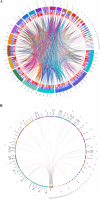The first complete mitochondrial genome of Curcuma amarissima (Zingiberaceae): insights into multi-branch structure, codon usage, and phylogenetic evolution
- PMID: 40188039
- PMCID: PMC11971759
- DOI: 10.1186/s12864-025-11540-x
The first complete mitochondrial genome of Curcuma amarissima (Zingiberaceae): insights into multi-branch structure, codon usage, and phylogenetic evolution
Abstract
Background: As a key genus in Zingiberaceae, Curcuma is widely studied for its taxonomic diversity, the presence of bioactive curcuminoids and volatile oils, and its extensive applications in traditional medicine and economic products such as spices and cosmetics. Although chloroplast genomes have been assembled and published for over 20 Curcuma species, mitochondrial genomic data remain limited.
Results: We successfully sequenced, assembled, and annotated the mitogenome of Curcuma amarissima (C. amarissima) using both Illumina short reads and Nanopore long reads, achieving the first complete mitogenome characterization in the Zingiberaceae family. The C. amarissima mitogenome features a unique multi-branched structure, spanning 6,505,655 bp and consisting of 39 distinct segments. It contains a total of 43 protein-coding genes, 63 tRNA genes, and 4 rRNA genes, with a GC content of 44.04%. Codon usage analysis indicated a weak bias, with neutrality plot analysis suggesting natural selection as a key factor shaping mitochondrial codon usage in C. amarissima. The mitogenome provides valuable insights into genome size, coding genes, structural features, RNA editing, repetitive sequences, and sequence migration, enhancing our understanding of the evolution and molecular biology of multi-branched mitochondria in Zingiberaceae. The high frequency of repeat sequences may contribute to the structural stability of the mitochondria. Comparing chloroplast genome, phylogenetic analysis based on the mitochondrial genome establishes a foundation for further exploration of evolutionary relationships within Zingiberaceae.
Conclusions: In short, the mitochondrial genome characterized here advances our understanding of multi-branched mitogenome organization in Zingiberaceae and offers useful genomic resources that may support future breeding, germplasm conservation, and phylogenetic studies, though further research is necessary.
Keywords: Curcuma amarissima; Comparative genomics; Mitogenome; Phylogeny.
© 2025. The Author(s).
Conflict of interest statement
Declarations. Ethics approval and consent to participate: We collected fresh leaf materials of Curcuma amarissima for this study. The plant samples and experimental research comply with relevant institutional, national, and international guidelines and legislation. No specific permissions or licenses were required. Consent for publication: Not applicable. Competing interests: The authors declare no competing interests.
Figures





References
-
- Nass MM. Mitochondrial DNA: Advances, Problems, and Goals: Studies of size and structure of mitochondrial DNA relate to biogenesis and function of this organelle. Science. 1969;165(3888):25–35. - PubMed
-
- Liberatore KL, Dukowic-Schulze S, Miller ME, Chen C, Kianian SF. The role of mitochondria in plant development and stress tolerance. Free Radical Biol Med. 2016;100:238–56. - PubMed
-
- Atteia A, van Lis R, Tielens AG, Martin WF. Anaerobic energy metabolism in unicellular photosynthetic eukaryotes. Biochim Biophys Acta. 2013;1827(2):210–23. - PubMed
MeSH terms
Substances
Grants and funding
LinkOut - more resources
Full Text Sources
Research Materials
Miscellaneous

